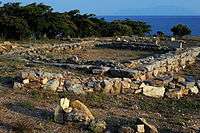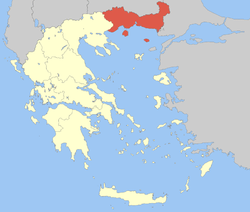Alexandroupoli
Alexandroupoli (Greek: Αλεξανδρούπολη, pronounced [aleksanˈðrupoli]) or Alexandroupolis is a city in Greece and the capital of the Evros regional unit in East Macedonia and Thrace. It has 57,812 inhabitants and is the largest (in size and population) city in Thrace and the region of Eastern Macedonia and Thrace. It is an important port and commercial center of northeastern Greece.[2]
Alexandroupoli Αλεξανδρούπολη | |
|---|---|
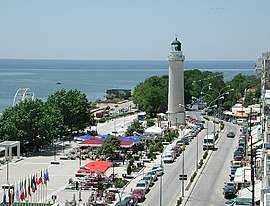 The lighthouse at the promenade, symbol of Alexandroupoli | |
 Alexandroupoli Location within the region  | |
| Coordinates: 40°51′N 25°52′E | |
| Country | Greece |
| Administrative region | East Macedonia and Thrace |
| Regional unit | Evros |
| Government | |
| • Mayor | Ioannis Zamboukis (Movement for Change) |
| Area | |
| • Municipality | 1,217.0 km2 (469.9 sq mi) |
| • Municipal unit | 642.2 km2 (248.0 sq mi) |
| Highest elevation | 11 m (36 ft) |
| Lowest elevation | 0 m (0 ft) |
| Population (2011)[1] | |
| • Municipality | 72,959 |
| • Municipality density | 60/km2 (160/sq mi) |
| • Municipal unit | 61,702 |
| • Municipal unit density | 96/km2 (250/sq mi) |
| Community | |
| • Population | 57.812 (2011) |
| Time zone | UTC+2 (EET) |
| • Summer (DST) | UTC+3 (EEST) |
| Postal code | 681 00 |
| Area code(s) | 25510 |
| Vehicle registration | ΕΒ |
| Website | www.alexpolis.gr |
Alexandroupoli is one of the newest cities in Greece, as it was only a fishing village until the late 19th century. According to Herodotus the modern city is near the site of ancient Sale,[3] a colony of Samothrace [4]. The zone of Alexandroupolis, as well as the whole area from the Evros Delta to Lake Vistonida and the foothills of Rhodope Mountains, was inhabited by Cicones. Cicones were Thracian people, with whom, according to mythology, Odysseus and his comrades clashed on their return from Troy [5].
Alexandroupoli benefits from its position at the centre of land and sea routes connecting Greece with Turkey.[6] Landmarks in Alexandroupoli include the city's lighthouse in the port, the archaeological sites of the Mesimvria Zone, the city's waterfront (the centre of commercial activity), the Ethnological Museum of Thrace, the thermal springs (Hana) of Traianoupoli, the cave of the Cyclops Polyphemus and the nearby Evros delta.[6]
Municipality
The municipality of Alexandroupolis was created in 2011 by the merger of the three former municipalities:[7]
- Alexandroupolis
- Feres
- Traianoupoli
The municipality has an area of 1,216.954 km2, the municipal unit 642.245 km2.[8]
Communities
The municipal unit Alexandroupoli is subdivided into the following communities (constituent settlements in brackets):
Name
The modern city of Alexandroupoli was founded as a small fishing village in the early 19th century, under the Ottoman Empire, by fishermen from Ainos and the villages of Makri and Maroneia.[6] It became known as Dedeağaç (Greek: Δεδεαγάτς; Turkish: Dedeağaç [dedeˈaːtʃ]; Bulgarian: Дедеагач [dɛdɛaɡat͡ʃ]). The name supposedly comes from an old Turkish wise man (Turkish dede) who spent much of his time under the shade of a tree (ağaç) and was eventually buried beside it. From the first days of the city's liberation (May 14, 1920), the local authorities as well as the Holy Metropolis, decided to rename the city from Dedeagac to Neapoli ("new city"), as it was until then the newest Greek city.[10] In 1920, King Alexander I of Greece visited the city, and the local authorities renamed the city Alexandroupoli ("city of Alexander") in his honor, with the approval of the central government.[11]
Geography
Alexandroupoli is about 14.5 km (9.0 mi) west of the delta of the Evros, 40 km from the border with Turkey, 346 km (215 mi) from Thessaloniki on the newly constructed Egnatia highway, and 750 km (470 mi) from Athens. Around the city are small fishing villages like Makri and Dikella to the west, and suburban Maistros, Apalos, Antheia, Aristino, Nipsa, Loutra to the east, while north of the city are the Palagia, Avantas, Aissymi, and Kirki. At the 2001 census, the main city had a population of 48,885 and the municipal unit had a population of 52,720. The current metropolitan population is estimated at around 70,000 inhabitants, and its area covers the southern portion of the regional unit, running from the Rhodope regional unit to the Evros Delta. Besides Alexandroupolis, its other largest settlements are the villages of Mákri (pop. 820), Ávas (497), Sykorráchi (309), Aisými (289), and Díkella (288).
Climate
| Climate data for Alexandroupoli | |||||||||||||
|---|---|---|---|---|---|---|---|---|---|---|---|---|---|
| Month | Jan | Feb | Mar | Apr | May | Jun | Jul | Aug | Sep | Oct | Nov | Dec | Year |
| Record high °C (°F) | 17.8 (64.0) |
21.4 (70.5) |
23.4 (74.1) |
27.0 (80.6) |
32.0 (89.6) |
36.8 (98.2) |
39.0 (102.2) |
37.4 (99.3) |
36.8 (98.2) |
32.6 (90.7) |
23.8 (74.8) |
23.2 (73.8) |
39.0 (102.2) |
| Average high °C (°F) | 8.4 (47.1) |
9.6 (49.3) |
12.3 (54.1) |
17.3 (63.1) |
22.4 (72.3) |
27.1 (80.8) |
30.1 (86.2) |
30.2 (86.4) |
26.4 (79.5) |
20.2 (68.4) |
15.1 (59.2) |
10.7 (51.3) |
19.1 (66.4) |
| Daily mean °C (°F) | 4.8 (40.6) |
5.8 (42.4) |
8.5 (47.3) |
13.2 (55.8) |
18.3 (64.9) |
23.0 (73.4) |
25.6 (78.1) |
25.2 (77.4) |
21.0 (69.8) |
15.5 (59.9) |
11.0 (51.8) |
7.0 (44.6) |
14.9 (58.8) |
| Average low °C (°F) | 1.1 (34.0) |
1.9 (35.4) |
3.7 (38.7) |
7.1 (44.8) |
11.1 (52.0) |
14.8 (58.6) |
17.4 (63.3) |
17.2 (63.0) |
14.0 (57.2) |
10.1 (50.2) |
6.7 (44.1) |
3.3 (37.9) |
9.0 (48.2) |
| Record low °C (°F) | −13.2 (8.2) |
−14 (7) |
−13.6 (7.5) |
−2.4 (27.7) |
1.0 (33.8) |
7.0 (44.6) |
9.0 (48.2) |
8.4 (47.1) |
0.0 (32.0) |
−2 (28) |
−6.2 (20.8) |
−8.8 (16.2) |
−14 (7) |
| Average precipitation mm (inches) | 60.4 (2.38) |
61.2 (2.41) |
52.3 (2.06) |
39.6 (1.56) |
36.3 (1.43) |
27.3 (1.07) |
17.6 (0.69) |
10.6 (0.42) |
31.0 (1.22) |
50.5 (1.99) |
75.7 (2.98) |
86.8 (3.42) |
549.3 (21.63) |
| Average precipitation days (≥ 1.0 mm) | 6.8 | 6.1 | 5.8 | 5.5 | 5.1 | 3.4 | 2.5 | 1.5 | 2.7 | 4.6 | 6.6 | 8.2 | 53.8 |
| Average relative humidity (%) | 74.9 | 73.6 | 73.0 | 71.3 | 68.6 | 60.6 | 54.4 | 53.3 | 59.7 | 67.6 | 75.2 | 76.7 | 67.4 |
| Source: NOAA[12] | |||||||||||||
History
From Neolithic Period to the 19th century
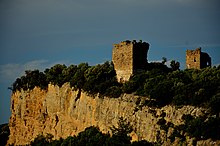
Human settlements appear since the Neolithic Period (4500-3000 BC) at the southeast end of Western Thrace. In the Bronze Age (3000-1050 BC) there is no strong evidence of active city participation. During the Early Iron Age (1050-650 BC) the various Thracian tribes appeared and settled in mountainous and, more rarely, in lowland areas. In the Byzantine Period, Alexandroupolis played a leading role, because the city bordered with Constantinople and for this reason was guarded by powerful military installations. In the following years, however, up to the 19th century, the city seems to be deserted and covered by forests and wild trees.[13]

The city was first settled in the 19th century, under the Ottoman Empire. Long used as a landing ground for fishermen from the coast of Samothrace opposite, a hamlet developed in the area during the construction of a railway line connecting Constantinople to the major cities of Macedonia from Kuleliburgaz. The work was part of an effort to modernise the Empire, and was assigned to engineers from Austria-Hungary. The settlement soon grew into a fishing village, Dedeağaç.
In 1873, it was made the chief town of a kaza, to which it gave its name, and a kaymakam was appointed to it. In 1884, it was promoted to a sanjak, and the governor became a mutasarrıf. In 1889, the Greek archbishopric of Aenus was transferred to Dedeağaç.[14] In the late 19th and early 20th century, Dedeağaç was part of the Adrianople Vilayet.
Russo-Turkish War
Dedeağaç was captured by the Russians during the Russo-Turkish War (1877–1878), and Russian forces settled in the village. The officers in charge saw that reconstruction incorporated wide streets running parallel to each other, allowing the quick advance of troops, and avoided cul-de-sacs. This was very unlike the narrow alleys, cobbled streets, and dead-ends that were characteristic of Ottoman cities at the time. The city returned to Ottoman control by the end of the war, but the brief Russian presence had a lasting effect on the design of Alexandroupoli's streets.[15]
Balkan Wars
The building of a railway station in Dedeağaç led to the development of the village into a town, and a minor trade centre by the end of the century. The town became the seat of a pasha as the capital of a sanjak. Ottoman control of the town lasted until the Balkan Wars. On 8 November 1912, Dedeağaç and its station was captured by Bulgarian forces with the assistance of the Hellenic Navy. Bulgaria and Greece were allies during the First Balkan War, but opponents in the Second Balkan War. Dedeağaç was captured by Greek forces on 11 July 1913. The Treaty of Bucharest (10 August 1913) however, determined that Dedeağaç would be returned to Bulgaria along with the rest of Western Thrace.
In September 1913, after the end of the Second Balkan War, about 12,000 Bulgarian refugees took refuge in the outskirts of the city. They were from 17 different villages all over the Western Thrace fleeing ethnic cleansing.[16]
World War I
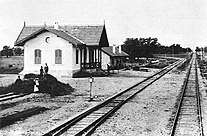
The defeat of Bulgaria by the Allies in World War I (1914–1918) ensured another change of hands for the town. Western Thrace was withdrawn from Bulgaria under the terms of the 1919 Treaty of Neuilly.[17] Alexandroupoli was under temporary management of the Entente led by French General Charpy.[18] In the second half of April 1920 in San Remo conference of the prime ministers of the main allies of the Entente powers (except United States), Western Thrace was given to Greece. However, Bulgaria retained the right of transit to use the port of Dedeagach to transport goods through the Aegean Sea. The change of guard between French and Greek officials occurred on May 14, 1920, in the city's Post Office.[19] In the interior of the Post Office there is a memorial plaque concerning this event. The city was soon visited by Alexander of Greece. He was the first King of Greece to visit the town which was renamed in his honour.[20]
Greco-Turkish War
Following the defeat of Greece in the Greco-Turkish War (1919–1922), the Greek Army under General Theodoros Pangalos retreated from Eastern Thrace to the area of Alexandroupoli. Bulgaria used the opportunity of the Greek defeat to demand that Alexandroupoli either be returned to its control or declared a neutral zone under international control. Both demands were soundly rejected by the Greek leadership and found no support in the League of Nations. The Treaty of Lausanne (24 July 1923) affirmed the Greek sovereignty on Western Thrace.
World War II
During World War II (see Axis occupation of Greece), the Nazis gave Alexandroupoli to their Bulgarian partners.[21] Alexandroupoli was subsequently under Bulgarian occupation between May 1941 and 1944. The city suffered some damage to buildings and loss of population during the war, but was largely spared the effects of the Greek Civil War (1946–1949). Forces of the communist Democratic Army of Greece in and around the town area were small and loosely organized, resulting in the absence of major battles in the area; the return of peace allowed for Alexandroupoli to grow from a town of 16,332 residents in 1951 to a city of 57,812 residents by 2011.
Transport[22]
Alexandroupolis is accessible by all means, by air, by train, by road, and by sea. Notable infrastructure projects are the modern-international port "Dimokritοs", the Egnatia Motorway and the railway connection with major cities. Bicycle lanes also run in the city center.
Airport
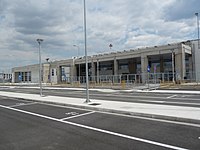
Alexandroupoli is served by Dimokritos International Airport (IATA:AXD) in the suburbs of Apalos, about 6 km from Alexandroupoli city center. There are daily flights to Athens, and also flights to Crete, while during the summer months some seasonal flights operate to/from Germany and Russia. The airport is connected to the city by highway, taxi services, and scheduled bus services.
Seaport
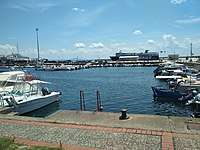
The port of Alexandroupolis has been used principally by travelers and there are daily services to the Island of Samothrace.
Railway
Alexandroupoli has one railway station: Alexandroupoli or Alexandroupoli Port. It is served by trains to Thessaloniki and to Dikaia.[23] There is an extensive network of train and bus replacements services throughout the region of Evros. There were railway connections to Burgas in Bulgaria and to Edirne and Istanbul in Turkey, but those were suspended.
Bus
The bus network has hourly buses to the major municipalities within Macedonia and Thrace offered from the Regional Coaches KTEL as well as daily services to Bulgaria and Turkey. OSE-Varan and Ulusoy have daily services to Istanbul and Athens each and depart from Alexandroupolis Railway Station in early mornings.
Media[24]
Television
There are 3 regional television stations operating in Alexandroupolis: Delta TV, Thraki NET (Thrace Television Network), ALFA TV.
Press
Daily active newspapers
- Eleftheri Thraki (Free Thrace)
- I Gnomi tis Thrakis (The opinion of Thrace)
Weekly active newspapers
- Mahitis tou Evrou (Fighter of Evros)
- Politis tis Thrakis (Citizen of Thrace)
- Thraki Press (Thrace Press)
Radio
The main Radio Stations broadcasting from Alexandroupoli are:
- NRG
- Polis
- Status Radio
- Thraki Fm
- Heat Radio
- Delta Fm
- Kanali 5 (Channel 5)
- Radio Dee Jay
- Maximum
- Yparho
- Radio Elpida
- Radio Alfa
Sites
Local information in electronic form is done through the pages "e-evros", "Alexpolisonline", "evros24" and "evrosnews".
Culture
Wine Festival

Until 80s in the city, the Wine Festival was held under the auspices of the Greek National Tourism Organization (EOT). This celebration revived after 25 years, in the summer of 2013 at the initiative of the Municipality of Alexandroupolis and is the city's greatest cultural event. The city's and Evros's regional unit cultural associations offer red and white local wine along with various meats.[25]
Ecopark "Altinalmazis"
Since May 2017, Alexandroupolis has a new 1400-seat garden theatre in "Ecopark Altinalmazis ", where various cultural events such as theatrical performances and concerts are held. It has an area of 135,597 sq.m. (80 acres) and has a refreshment, walkways, green spaces and kiosks. This park is named after Konstantinos Altinalmazis, Alexandroupolis's longest-serving mayor (1925–29, 1929–33, 1933–37,1937-41).[26]
Each year, in the summer on the coast avenue of King Alexander, book exhibition is held, and every two years near the harbor the international trade fair "Alexpo" is organized.[27]
On 14 May each year, the annexation of the city and Thrace to Greece is celebrated by a parade. The city's patron saint is Saint Nikolaos, whose feast is celebrated on 6 December each year.[28][29]
Sights
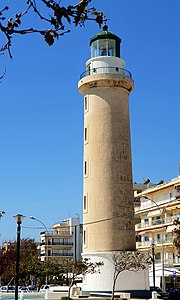
The Lighthouse of Alexandroupoli
Attraction and symbol of the city is the Lighthouse (recognized as a cultural heritage monument in 2013) located on the city's promenade (Megalou Alexandrou Street). It was built in 1850 and started operating in 1880, built on the western side of the city's harbor to facilitate the coasting of local sailors who traveled to the area of Hellespont. It is on a cylindrical pedestal and is 27 meters from the average sea level and 18 meters from the ground, making it one of the tallest lighthouses in Greece. It operates with electricity and its distinctive feature is its light beam reaching 24 nautical miles (approximately 44 km) and three white blinks every 15 seconds.[30]
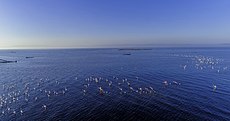
Evros Delta
Just 20 miles from the city, the Evros Delta is one of Europe's most important habitats with 200,000-acre area, which is on the list of protected areas of the International Ramsar Convention (1971) due to the significant and rare species of plants (more than 300 species), fauna (40 species of mammals, 28 species of reptiles and 46 species of fish) and birds(320 species). Part of the Delta has been designated as a Special Protection Area and is proposed as a Site of Community Interest in the Natura 2000 Network.[31]
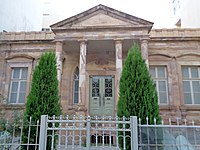
Ethnological Museum of Thrace
It is housed in a 1899 built neoclassical stone building on 14 May, 63 street, and has been operating since October 2002 to preserve historical memory in the wider geographical area of Thrace. It includes exhibits on the tradition of Thrace and covers the following themes: clothing, music and worship, confectionery, bronze and earthenware, textiles, land cultivation.[32]
Cave of Cyclops
It is located in Makri and is a famous cave of the Cyclops Polyphemus according to local folk tradition. It has traces of use since the Neolithic period (about 4,500 BC) and today the Neolithic settlement, one of the most important in the Balkans, has been discovered.
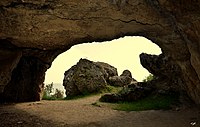
Mesimbria-Zone
Mesimbria-Zone is an archaeological site 20 km from Alexandroupolis. A number of coins and ruins from an ancient city, probably Zone, have been found here. It was one of the colony-fortresses of Samothrace and flourished in the 5th and 4th centuries BC. The main buildings are: the sanctuary of Demeter, the temple of Apollo, the fortification wall, the walled settlement of the Hellenistic years, the cemetery and the Residences.[33]
Thermal springs of Traianoupoli
The thermal springs of Traianoupoli are 14 km away from the city of Alexandroupolis and are of the most famous hot springs in the region, since ancient times. Hana was an Ottoman inn and behind it during the Ottoman Empire there were baths (hamams), today ruins from the 16th century. In 1964, modern facilities for bath therapy and positherapy were rebuilt at the archeological site, which are officially recognized by the Greek state for their healing properties and are considered one of the most important in Greece.[34]
Museums[35]
- Historical Museum of Alexandroupolis (335, Democracy Avenue)
- Ethnological Museum of Thrace (63, 14 May street)
- Archaeological Museum of Alexandroupolis (44, Makris Avenue)
- Ecclesiastical Museum of the Holy Metropolis of Alexandroupolis (Mitropoleos Square)
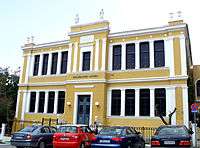 Ecclesiastical Museum of Alexandroupolis
Ecclesiastical Museum of Alexandroupolis - Folklore Museum of Cappadocian Association of Alexandroupolis (1, Mitropoulou street)
- Museum of Folklore and Natural History (8, Thermopylae street, Nea Chili)
- Museum of Natural History (Platanopathos of Maistros)
- Museum of Flora and Fauna (Art & Culture Center of the Municipality of Alexandroupolis "Georgios Vizyinos")
Historic Preserved Buildings of architectural interest[36]
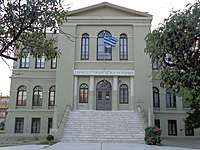 Zariphios Educational Academy founded by Georgios Zariphis
Zariphios Educational Academy founded by Georgios Zariphis Old "Kapnomagazo" (tobacco store), the new municipal library of Alexandroupolis
Old "Kapnomagazo" (tobacco store), the new municipal library of Alexandroupolis The οld hospital of Alexandroupolis, which now is used as a Music High School
The οld hospital of Alexandroupolis, which now is used as a Music High School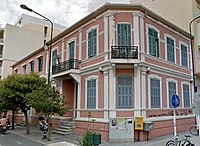 The historic building of the National Bank which houses the Reading Room of the Democritus University of Thrace
The historic building of the National Bank which houses the Reading Room of the Democritus University of Thrace Alexandroupoli's port customs buildings
Alexandroupoli's port customs buildings The old building of the 1st primary school of Alexandroupolis
The old building of the 1st primary school of Alexandroupolis The 3rd Primary school of Alexandroupolis which is housed in the courtyard of the Metropolis
The 3rd Primary school of Alexandroupolis which is housed in the courtyard of the Metropolis
- Zariphios Pedagogical Academy
- Kapnomagazo (Tobacco store)
- Old Hospital
- Democritus University of Thrace Building (Reading room)
- Port Custom Buildings
- 1st Primary School
- 3rd Primary School
Education
Alexandroupoli houses four Departments of the Democritus University of Thrace. These Departments are the following:
- Department of Medicine[37]
- Department of Molecular Biology and Genetics[38]
- Department of Primary Level Education[39]
- Department of Education Sciences in Early Childhood[40]
Some highly specialised medical operations are performed in the new Regional General University Hospital – Research center, currently the largest one in Greece.[41] The Department of Molecular Biology and Genetics is the only one in Greece in this scientific field.[42]
The city has a network of public schools, from nurseries to high schools, under the responsibility of the city council.
Sport
Volleyball
The Volleyball team of Ethnikos Alexandroupolis has a long-standing presence in the Greek Volleyleague with a long history in the sport, being the first provincial team to participate in the A1 Volleyball championship (42 years). He has made significant progress in all three home titles (Championship, Cup, League Cup), reaching the final (2014) and 8 times the first 4 teams in ranking, but also in European competitions, reaching two times the quarterfinals of the CEV Challenge Cup in 2015 and 2016. He has also featured great athletes of the Greek and global volleyball such as Marios Giourdas, Theodoros Baev and Andreas Andreadis, while Thanassis Moustakidis, Andrej Kravárik and Nikos Samaras also wore his shirt. He has also won many national championships in the infrastructure departments. In total, she has won 5 Junior Leagues in Greece (1976, 1987, 2011, 2012, 2013), 2 Greek Children's Championships (2008, 2011), 3 Greek Championships of Junior children (2007, 2008, 2009). The headquarters of the team is the closed gym of "Michalis Paraskevopoulos", 1000 seats, located next to the Fotis Kosmas athletic stadium.[43]
Other city's Volleyball Teams are:
- G.S.G. Nike Alexandroupolis: Women's team with 9 participations in Women's Greek Volleyball Championship and best place the 4th (1997–98), that allowed the team to participate in Challenge Cup. Nike has won 2 National Junior championships (1990, 1992) and 1 National Girls Championship (1989).
- G.E. Alexandroupolis, which has competed in the A2 Men's Volleyball category.
- Finikas Alexandroupolis, women's volleyball team, which competes in the A2 Women's Volleyball category
Football
The main sporting facilities are situated around the football and athletics stadium Fotis Kosmas. The stadium hosts various football teams, such as:
| Notable football clubs based in Alexandroupolis | |||
|---|---|---|---|
| Club | Sports | Founded | Achievements |
| MGS Ethnikos Alexandroupolis | Football | 1927 | Earlier presence in 2nd Greek Division |
| Enosi Alexandroupoli F.C. | Football | 1995 | Earlier presence in 3rd Greek Division |
| Alexandroupoli F.C. | Football | 2019 | 4th Greek Division (2019-20) |
Basketball
There are two basketball teams in the city: Ethnikos Alexandroupolis and Olympiada Alexandroupolis. Each game between them is a local derby. These two teams compete in the regional basketball championship of East Macedonia and Thrace. Ethnikos Alexandroupolis has celebrated two rises and participations in the Greek C Basket League (1995, 2014), counting equal relegations. The biggest success of the team's academy is the 3rd place in the National Children Basketball Championship in 1983/84.[44]
Handball-Beach Handball
In beach handball the team of Kyklopes Alexandroupolis has 5 National Beach Handball Championships, 4 of them consecutive (2016, 2017, 2018, 2019) [45].The women's handball team has 7 participations in the Women's A1 Handball Championship with best place the third in 1994-95 that allowed the team to participate in Challenge Cup next year [46]. Also the men's team of Kyklopes participates in the A2 Ethniki Handball.
Swimming
In June 2013 was inaugurated the new Municipal Swimming Pool of Alexandroupolis "Dimosthenis Michalentzakis", which is the most modern swimming pool in Greece in terms of technical equipment and one of the most modern in Europe. In this place have been hosted major international events, such as the international synchronized swimming meeting Hellas Beetles Fina Artistic Swimming World Series, in April 2019. It is the headquarters of the swimming clubs: OFTHA and NOA, but also of the polo team of Ethnikos Alexandroupolis. The OFTHA team has held the first place in Thrace for several years and is one of the top clubs in Greece, while many of its athletes have achieved distinctions in national championships [47].
Track
The track team of Ethnikos Alexandroupolis also has a great tradition as has been in the first 10 teams of the Greek track championship ranking 4 times in men (1953, 1955, 1956, 1958), best place the 4th (1956), and in women (1959, 1989, 1990, 1991), best place also the 4th (1959). It has featured great athletes such as: Hrysopigi Devetzi, Dimosthenis Magginas and Fotis Kosmas. Many athletes of the team have won Panhellenic and Balkan medals in development categories.[48]
Table Tennis[49]
The 10 recent years, Ethnikos Alexandroupolis has been consistently among the top 10 teams in Greece according to the Hellenic Table Tennis Federation rating tables. The women's team has been participating in the A2 National Championship for 5 consecutive years, while the Men's team has been participating in the Second National North Greece Championship having the youngest average age in the league.
As far as infrastructure teams are concerned, the club was 4 times in the finals of the Panhellenic Junior Children Championship (2016, 2017, 2018, 2019). In 2017 he won the 1st place and was the Greek Champion in this category, while in 2016, 2017, 2019 he won the 2nd place in Greece. In the category of Children, in 2017 and 2018 the team of Ethnikos Alexandroupolis took the 3rd place in the Panhellenic Table Tennis Championship and in 2019 was the champion in this category and climbed to the top of Greece. In 2019, Ethnikos Alexandroupolis took the 2nd place in the Panhellenic Table Tennis Championship in the category of Young Women.
Athletes of the club are at the top of the federation's ranking list by winning cups and medals at the Panhellenic Open Championships.
Badminton
Since 2018, the Badminton department of Ethnikos Alexandroupolis has been competing in the A1 Greek Badminton Division, while club's athletes have won medals at the Panhellenic Development Championships.[50]
Rugby
In 2009, the stadium hosted an international rugby match between Greece and Bulgaria; the match was the first time that Greece had played a home match outside of Attica.[51]
Run Greece Alexandroupolis
Since 2014, with the help of the track team of Ethnikos Alexandroupolis, Run Greece Alexandroupolis is held, which continues until today, on the last Sunday of September, co-organized by SEGAS, Municipality of Alexandroupolis and Region of Eastern Macedonia and Thrace. Run Greece includes 800m race for children and races 5 km, 10 km.[52]
Via Egnatia Run
The international race 'Via Egnatia Run' is an action of Evros Regional Unit which started in 2016 and is being held every May. It is a 21.1 km half-marathon on the route of the Ancient Via Egnatia, which once connected Constantinople to Rome, culturally, economically and commercially, passing through the ancient city of Sale (today's Alexandroupoli) and Traianoupoli. There is also a race of 5 km, and two races of 800 meters for disabled people and children. It takes place on the Alexandroupolis-Kipoi National Road and the routes have been certified by the Association of International Marathons and Distance Races (AIMS). The goal is through the sport to get to know the culture and history of this important route.[53]
International relations
Twin towns – sister cities

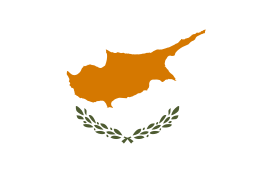




Notable people
- Hrysopiyi Devetzi (1976), Greek athlete, silver Olympic medalist in triple jump (Athens 2004)
- Fotis Kosmas (1926-1995), Mediterranean and 7th Olympic winner in decathlon
- Aggeliki Tsiolakoudi (1976), second biggest Greek Javelin thrower
- Dimosthenis Magginas (1982), middle-distance and long-distance runner
- Dimosthenis Michalentzakis (1998), Greek Gold Paralympic champion swimmer in category S9 (Rio, 2016)
- Demis Nikolaidis (1973), Greek former international footballer, Euro 2004 champion
- Marinos Ouzounidis (1968), Greek former international footballer, football coach
- Manolis Siopis (1994), Greek international footballer
- Savvas Gentsoglou (1990), Greek footballer
- Stavros Stathakis (1987), Greek footballer
- Dimitris Komesidis (1988), Greek footballer
- Athanasios Tsigas (1982), Greek former footballer
- Marios Giourdas (1973), Greek former international volleyball player
- Rafail Koumentakis (1993), Greek international volleyball player
- Anestis Dalakouras (1993), Greek international volleyball player
- Paraskevas Tselios (1997), Greek international volleyball player
- Giorgos Valavanidis (1974), Greek former basketball player, silver medalist with Greek National team U16 in Eurobasket U16 1991, Saporta winner in 1991, Greek champion in 1992 and Korac winner in 1994 with PAOK
- Nikos Hadjinikolaou (1962), Greek journalist
- Lefteris Hapsiadis (1953), Greek Lyrics creator and writer
- Stavento (Michalis Kouinelis) (1979), Greek hip-hop singer
- Arete Kosmidou (1997), Greek singer
- Gregoris Mentzas (1960), Greek management scientist and professor at the National Technical University of Athens
- Georgios Kandilaptis (1881-1971), Greek scholar, journalist and teacher
- Konstantinos Malamatinas, founder of retsina Malamatina [60]
Historical population
Alexandroupolis is the 11th largest city in Greece.[61]
| Year | Town | Municipal unit | Municipality |
|---|---|---|---|
| 1940 | 19.384 | _ | _ |
| 1951 | 18.916 | _ | _ |
| 1961 | 21.209 | _ | _ |
| 1971 | 25.529 | _ | _ |
| 1981 | 35.799 | 35,799 | – |
| 1991 | 39.261 | 38,220 | – |
| 2001 | 50.017 | 52,720 | – |
| 2011 | 57,812 | 58,125 | 72,959 |
Gallery
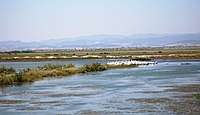 Evros Delta
Evros Delta Statue of Domna and Antonis Visvizis, heroes of the Greek War of Independence from Thrace
Statue of Domna and Antonis Visvizis, heroes of the Greek War of Independence from Thrace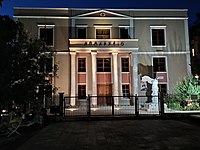 The building of the regional unit of Evros and with an exact copy of the Winged Victory of Samothace in the courtyard
The building of the regional unit of Evros and with an exact copy of the Winged Victory of Samothace in the courtyard- St Joseph's Catholic church
- Ottoman baths in nearby Traianoupoli
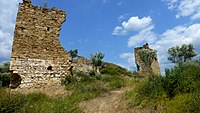 The castle of Avas
The castle of Avas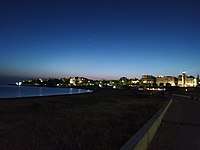 View of the coastal area of Alexandroupoli
View of the coastal area of Alexandroupoli- Sunset in Alexandroupoli
- View of Samothrace from the city
- Coast along Alexandroupoli
- Beach with view to Samothrace
 Russian monument in the yard of the metropolitan church for the Russo-Turkish War (1877–1878)
Russian monument in the yard of the metropolitan church for the Russo-Turkish War (1877–1878)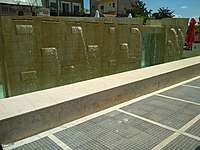 Eleftherias Square
Eleftherias Square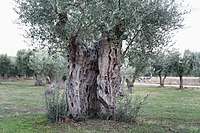 Olive grove in Alexandroupolis
Olive grove in Alexandroupolis
See also
- Burgas-Alexandroupoli pipeline
- List of settlements in the Evros regional unit
- Ethnikos Alexandroupolis
- Alexandroupolis Airport
- Thrace
- Evros
References
- "Απογραφή Πληθυσμού - Κατοικιών 2011. ΜΟΝΙΜΟΣ Πληθυσμός" (in Greek). Hellenic Statistical Authority.
- "The comparative advantages of Alexandroupolis as a transit center and energy hub". bigbusiness.gr (in Greek). Retrieved 2019-10-06.
- D. C. Samsaris, Historical Geography of Western Thrace during the Roman Antiquity (in Greek), Thessaloniki 2005, p. 126
- http://www.xanthi.ilsp.gr/thraki/history/his.asp?perioxhid=R0001
- "Thracian online treasure - History". www.xanthi.ilsp.gr. Retrieved 2020-06-20.
- http://www.visitgreece.gr/en/mainland/alexandroupolis
- Kallikratis law Greece Ministry of Interior (in Greek)
- "Population & housing census 2001 (incl. area and average elevation)" (PDF) (in Greek). National Statistical Service of Greece. Archived from the original (PDF) on 2015-09-21.
- "Detailed census results 1991" (PDF). Archived from the original (PDF) on 2016-03-03. (39 MB) (in Greek and French)
- "Dedeagac, Neapoli, Alexandroupoli (the topic of the city's naming)". www.ordteo.gr. Retrieved 2020-06-20.
- "Alexandroupoli - Thrace" (in Greek). Retrieved 2019-10-07.
- "ALEXANDROUPOLIS Climate Normals 1961–1990". National Oceanic and Atmospheric Administration. Retrieved January 29, 2013.
- "History of Alexandroupolis". Retrieved 2019-08-29.
-

- "The history and liberation of Alexandroupoli". e-evros.gr (in Greek). Retrieved 2019-08-21.
- Л. Милетичъ, Разорението на Тракийскитѣ българи прѣзъ 1913 година, р.222
- "Treaty of Neuilly, article 27 (3), 48". Lib.byu.edu. Retrieved 2014-03-05.
- "New Rule in West Thrace, The New York Times, December 8, 1919" (PDF). New York Times. 1919-12-08. Retrieved 2014-03-05.
- "Grafiki Palia Alexandroupoli". Oldalexandroupoli.gr. 1920-05-14. Retrieved 2014-03-05.
- "The history of Alexandroupoli". Alexandroupoli Online. Retrieved 2019-10-07.
- K.Svolopoulos, Greek Foreign Policy 1945–1981
- "About Alexandroupolis". alexandroupolis-likehome.com. Retrieved 2019-10-06.
- TrainOSE schedule Archived 2013-01-19 at the Wayback Machine
- "Media in Alexandroupolis, Evros". vrisko. Retrieved 2019-10-06.
- Korologou, Maria. "After 25 Years, Alexandroupoli Wines Again | GreekReporter.com". Retrieved 2019-10-06.
- e-evros.gr. "Ecopark "Altinalmazis" - Alexandroupoli". e-evros.gr (in Greek). Retrieved 2019-10-06.
- "Opened the 18th International Trade Fair 2018 ALEXPO". evros24.gr (in Greek). 2018-06-16. Retrieved 2019-10-06.
- "14th May, Alexandroupoli celebrates the freedom of the city". Alexandroupoli Online. Retrieved 2019-10-06.
- "Alexandroupoli celebrates the patron of the city Saint Nikolaos". Alexandroupoli Online. Retrieved 2019-10-06.
- "Alexandroupolis Lighthouse". e-evros.gr (in Greek). Retrieved 2019-10-07.
- "EVROS-The Evros Delta". www.wwf.gr. Retrieved 2019-10-07.
- "Ethnological Museum of Alexandroupolis | Eastern Macedonia - Thrace". www.emtgreece.com. Retrieved 2019-10-07.
- "Archaeological Site of Mesimvria - Zone | Greek Travel Pages". www.gtp.gr. Retrieved 2019-10-07.
- "The thermal springs of Traianoupolis are being upgraded". ert.gr. Retrieved 2020-07-13.
- "Evros - Museums". Terrabook. Retrieved 2019-10-07.
- "Historic buildings of Alexandroupolis that have been declared preserved". www.ordteo.gr. Retrieved 2020-07-13.
- "med.duth.gr". Archived from the original on 2016-06-20. Retrieved 2010-01-06.
- mbg.duth.gr
- eled.duth.gr
- "psed.duth.gr". Archived from the original on 2016-05-16. Retrieved 2010-01-06.
- "University General Hospital of Alexandroupolis" (in Greek). Retrieved 2019-10-04.
- "The Department of Molecular Biology and Genetics, DUTH". www.mbg.duth.gr. Retrieved 2019-07-17.
- "M.G.S. Ethnikos Alexandroupolis > Historical file (13. Volleyball)". mgs-ethnikos.gr. Retrieved 2019-10-07.
- "Ethnikos Alexandroupolis Basketball academies".
- "5 times National Championships in beach handball, Kyklopes Alexandroupolis".
- "European Handball Federation - AS Kiklopes Alexadroupolis". www.eurohandball.com. Retrieved 2020-06-08.
- "The mirror of each club are its distinctions".
- "Ethnikos Alexandroupolis track academies". mgs-ethnikos.gr. Retrieved 2019-08-15.
- "Ethnikos Alexandroupolis Academies> Table Tennis". mgs-ethnikos.gr. Retrieved 2019-10-04.
- "Badminton Ethnikos Alexandroupolis".
- "ESPN Scrum.com". ESPN Scrum.com. Retrieved 2014-03-05.
- "Run Greece Alexandroupolis-programme" (PDF).
- "Alexandroupoli: 1.500 runners will run in VIA EGNATIA RUN 2019". ert.gr (in Greek). 2019-05-10. Retrieved 2019-10-07.
- "Αδελφοποίηση της Αλεξανδρούπολης με Μπουργκάς και Αγία Πετρόπουλη". evros-news.gr (in Greek). Evros News. 2017-05-25. Retrieved 2020-06-02.
- "Αδελφοποιήσεις". lakatamia.org.cy (in Greek). Lakatamia. Retrieved 2020-06-02.
- "Τι ενώνει την Αλεξανδρούπολη με την Συμφερόπολη της Κριμαίας". pontos-news.gr (in Greek). Pontos News. 2016-02-22. Retrieved 2020-06-02.
- "Meeting with delegation of Alexandroupoli (Hellenic Republic)". kvs.spb.ru. Committee for External Relations of Saint-Petersburg. 2014-03-26. Retrieved 2020-06-02.
- "Константин Габаэридис назначен советником губернатора Санкт-Петербурга". spbdnevnik.ru (in Russian). Evros News. 2016-05-27. Retrieved 2020-06-02.
- "Russian consulate in Alexandroupolis reopens more than a century later". www.newgreektv.com. Retrieved 2019-10-07.
- "Retsina Malamatina: How began its production in 1895 from Alexandroupoli". EVROS NEWS (in Greek). Retrieved 2019-10-27.
- "List of cities in Greece", Wikipedia, 2019-05-29, retrieved 2019-07-17
External links
| Wikivoyage has a travel guide for Alexandroupolis. |
![]()
- Official website (in English and Greek)


